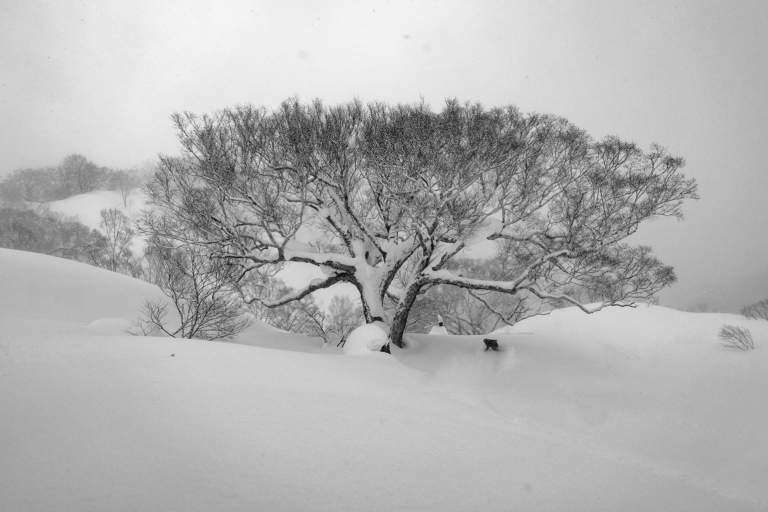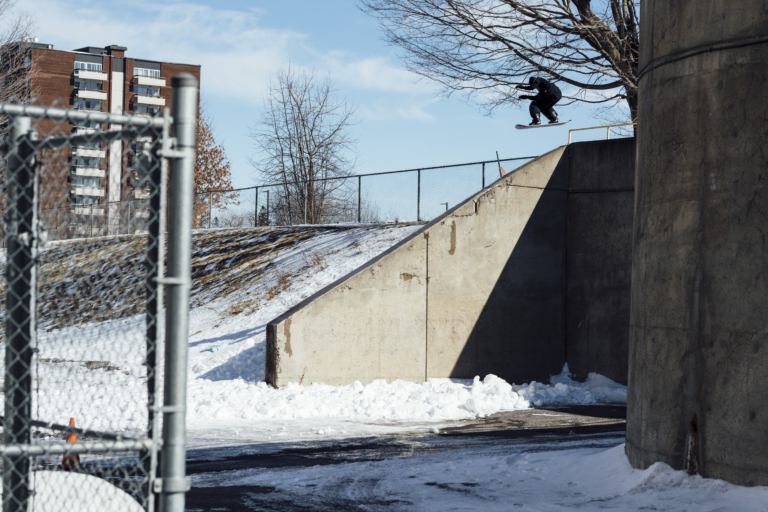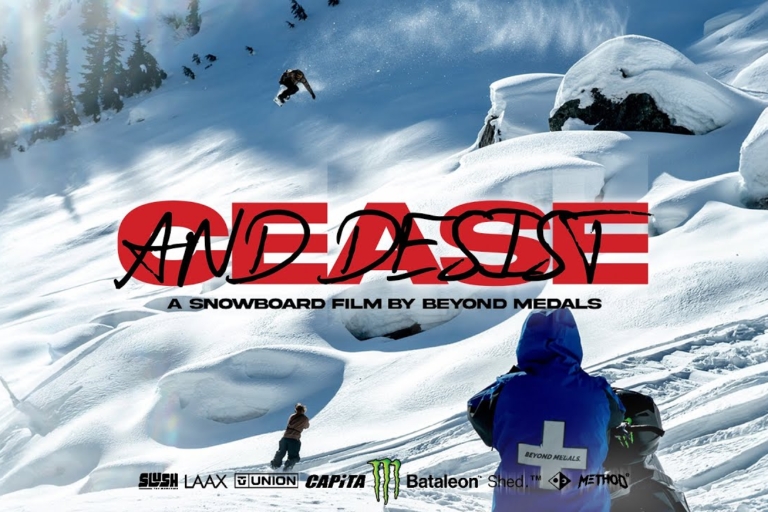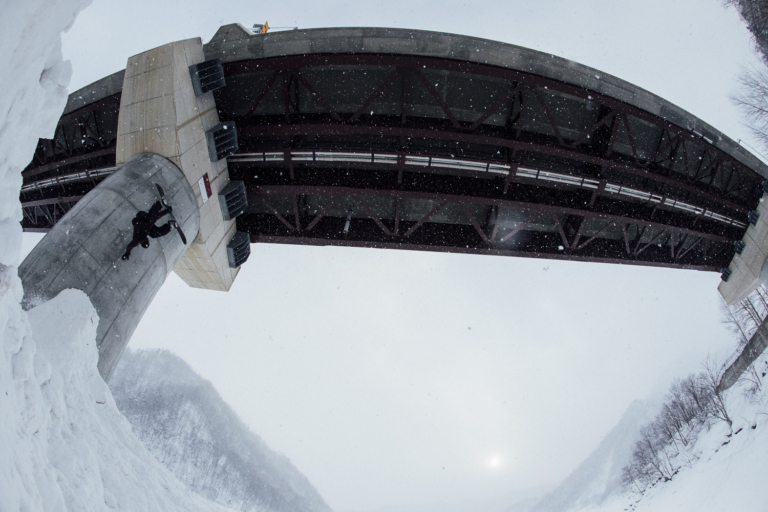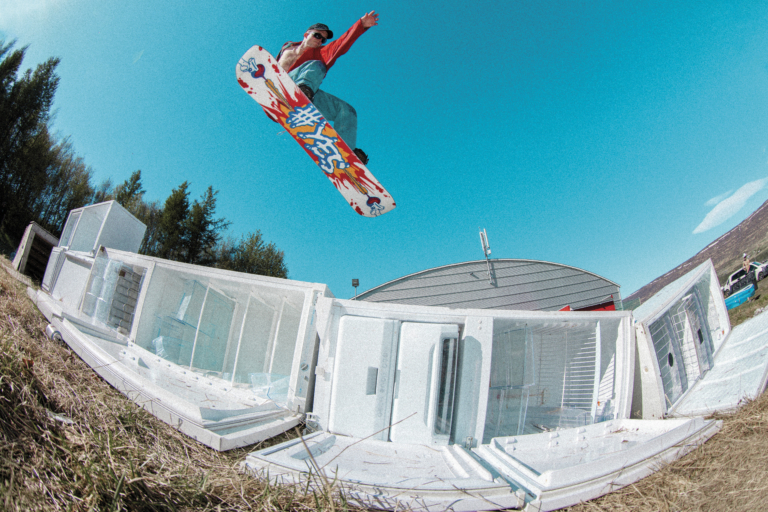[vc_row][vc_column width=”1/2″][vc_column_text]There are few names that carry the same weight within snowboarding as Travis Rice. Over the last twelve years, he has created six groundbreaking films, and each of them has had a monumental impact on the greater snowboard community in terms of both scope and scale. His first, The Community Project – the largest budgeted snowboard film of its time – set a precedent for excellence and progression. That’s It, That’s All shocked the world when its popularity quickly stretched beyond the narrow confines of the snowboard community. Over the past decade, this continued as one multi-year project after the next shattered expectations and opened our eyes to what is truly possible.
But continued success comes with its own baggage. As Travis’ name became synonymous with “the next big thing” we began to formulate our own preconceived notions for what that was. Our expectations grew to new heights, and[/vc_column_text][/vc_column][vc_column width=”1/2″][vc_column_text]any project with his name attached to it was subjected to criteria that stretched far beyond that of any other film. This season, Travis broke that mold for the first time with a scaled back, single-year project, that wasn’t on anyone’s radar until its release.
Depth Perception isn’t a new Travis Rice, it’s an evolved one. A Travis Rice that has walked away from each completed project with a greater understanding of himself, and a deeper appreciation for snowboarding. By forgoing the formulas that shaped his previous endeavors, Travis was free to explore a new line of thought – one where a snowboarding film is no longer solely comprised of action, but rather built upon the depths of its characters and their interactions with the natural world. A film that puts the experience, awareness, and community at its forefront. A film with substance. Depth Perception is Travis Rice, set free.[/vc_column_text][/vc_column][/vc_row][vc_row][vc_column][vc_column_text]
Photography by Andrew Miller, unless otherwise noted.
[/vc_column_text][/vc_column][/vc_row][vc_row][vc_column][vc_separator border_width=”8″][/vc_column][/vc_row][vc_row full_width=”stretch_row_content_no_spaces”][vc_column][vc_single_image image=”74393″ img_size=”full” alignment=”center”][/vc_column][/vc_row][vc_row][vc_column][vc_column_text]So how does it feel to finish Depth Perception after The Fourth Phase?
This one feels really good. And you know, the two projects are so incomparable really.
The Fourth Phase is still relevant, [it] is still something I’m really proud that we did and completed. It was a beast. Everything about it was big — the places we went, the challenges we took. Coming out of that project, we were a little cross-eyed and dizzy, honestly. I’ve always wanted to do a single location project, a detailed look at the symbiosis, climatology, the relationship between flora and fauna – really get into the nitty and gritty of what makes a place unique.
But, when you have multiple locations in a single film, you just can’t take the time to really dig deep into where you’re at and share that. Similarly, having just four riders on this project, we were able to show how dynamic each one of these individuals are. So, I think we needed it. Maybe for me, I needed it.
Most snowboard videos come out, you see it that season, and the next season there’s something else. The Fourth Phase had more of an encapsulating quality to it. It had life. But I can understand how, coming from that, it would be difficult to keep Depth Perception contained. It seems as if this project blew up to be a lot more than what it was meant to be. No one really heard about this film, and all of a sudden it’s this big thing.
One hundred percent. It wasn’t until we really put out the first teaser… We didn’t tell anybody about it. And it was kind of fun that way. There was absolutely no one else involved in the creative except for us. I wanted it to be fresh. This whole premiere tour I feel like a lot of people are just showing up to the premiere on the faith that it’s me. They’re coming out to watch it even though they know nothing about it. Whereas the last film, we had a lot more awareness and marketing, there was an engine behind it.[/vc_column_text][/vc_column][/vc_row][vc_row full_width=”stretch_row_content_no_spaces”][vc_column][vc_single_image image=”74389″ img_size=”full” alignment=”center”][/vc_column][/vc_row][vc_row][vc_column width=”2/12″][vc_custom_heading text=”“This whole premiere tour I feel like a lot of people are just showing up to the premiere on the faith that it’s me.“” font_container=”tag:h2|font_size:30|text_align:right|color:%23dd3333″ use_theme_fonts=”yes”][/vc_column][vc_column width=”8/12″][vc_column_text]Was that in the back of your head while you were filming, knowing that you have this network of people that will blindly trust what you’re doing?
It’s definitely not on the forefront, but of course it’s in the back of my mind. The project turned into something bigger than it initially was intended to be, because once we started filming, the crew dynamics with Robin [Van Gyn], Austen [Sweetin], and Bryan [Fox] were awesome. I love every one of these individuals for who they are. They’re all uncompromising, unique human beings. And so that, along with the crew being willing to chase all these hair brain ideas, to dive deep into snow and avalanche safety, into what it takes to be a mountain guide, into lifting the veil a little bit…
I mean the title itself, “Depth Perception,” that’s just it. Obviously, depth perception, the simple definition of it, is that we all have binocular vision which allows us the ability to scale distances due to size, and our ability to catalog simple definitions of things. But the goal of this film was to try to peel back that extra layer and see beneath the surface of our first impressions.
For instance, we see a tree, we consider it a tree, we call it a tree. It’s how our brains work to simplify the world, these super complex endeavors, the multidimensional world around us. But if you strip that away and look one step deeper into this dynamic organism, there’s so much mystery about how this thing is able to grow to its size, how it lives, what its relationship is to the forest around it, how these complementary species support its life. If just for a second you look at it without a preconceived idea of what it is, then the true magic of it starts to show.[/vc_column_text][/vc_column][vc_column width=”2/12″][/vc_column][/vc_row][vc_row full_width=”stretch_row_content_no_spaces”][vc_column][cq_vc_mediumgallery images=”74012,74011,73920″ layoutno=”3″][/vc_column][/vc_row][vc_row][vc_column width=”2/12″][/vc_column][vc_column width=”8/12″][vc_column_text]With Depth Perception, you were in one place and filmed it in one year. How long were you guys in Galena, Canada?
The shooting of this film took about five and a half weeks.
All one trip, or multiple trips?
Two trips. We did an initial trip for three weeks and it was great. Canadian Mountain Holidays [CMH] allowed us access and a guide. We got linked into their network, and John Buffery was a big part of the project. So we did our three weeks and we only saw the sun one day. And our goal with the project was to encapsulate all aspects of snowboarding in that region. So the fact that we didn’t get into the alpine, or get to really show that other side of snowboarding, at the end of it everyone doubled down.
“Whatever, forget Alaska this season, we’re all down to come back and pool all the resources we can.” Some of us were out of pocket to come back because we believed in it. And then I gave CMH a ring and I said, “Hey we have something special here, work with us, we’re more or less out of resources but we want to come back up and finish what we started.”
I was blown away. They came back to us and said, “Alright, we’re willing to give you the lodge and our staff all believes in what you’re doing. Come back when our guests leave and you guys can take the lodge for the last couple weeks of the season.” So we did, we went back up, and they provided a huge resource with the helis and the lodge. And then the rest of our partners, Quiksilver and Roxy, everyone pulled together and believed in us so we went back up and shot for another two and a half weeks and finished the project.[/vc_column_text][/vc_column][vc_column width=”2/12″][/vc_column][/vc_row][vc_row full_width=”stretch_row_content_no_spaces”][vc_column][vc_single_image image=”74392″ img_size=”full” alignment=”center”][/vc_column][/vc_row][vc_row][vc_column width=”2/12″][/vc_column][vc_column width=”8/12″][vc_column_text]Would you say it was a freedom or a constraint to be in one spot?
Freedom, no doubt.
Working with the cast as well? What was it like starting this project with people that were outside of your traditional crew?
Well it was cool because Quiksilver, especially in the States, is such a sleeper of a company. When you think of these top couple brands in snowboarding, Quiksilver is kind of on the side. But for me, what’s been really amazing, is the talent and the individuals that are supported by the brand, who have always been really in line with the things I love about snowboarding. I find myself laughing sometimes because they’re really almost more of a core snowboarding company than a lot of the truly “core” snowboarding companies out there.
So Bryan and I have been on the same team for quite some time, and in between our trips for The Fourth Phase I actually brought Bryan up to Alaska for his first trip to AK. We had three weeks and the conditions were amazing. We rode all over the place. And Fox is such an unassuming pro rider, yet he’s super talented and he’s got such a good head on his shoulders. So it started with Bryan, and we began it as a little Quiksilver project, and then Sweetin got on the team a number of years ago. He’s one of the guys that I look up to, he’s going to be one of the best big-mountain freestyle riders on the planet, hands down, bar none.
Those two were easy, and we actually tried to have a female rider come out with us for The Fourth Phase but things just didn’t line up. So [for Depth Perception] A, it was super mandatory, and B, it was super easy because Robin is Canadian, she’s a badass, she tears apart B.C. terrain, that’s her whole deal. She has more legit first responder, med, and avalanche certs than any of us. Bringing her onto the crew enhanced our whole program.[/vc_column_text][/vc_column][vc_column width=”2/12″][vc_custom_heading text=”“The goal of this film was to try to peel back that extra layer and see beneath the surface of our first impressions.“” font_container=”tag:h2|font_size:30|text_align:left|color:%23dd3333″ use_theme_fonts=”yes”][/vc_column][/vc_row][vc_row full_width=”stretch_row_content_no_spaces” gap=”10″][vc_column][cq_vc_parallax images=”74385″][/cq_vc_parallax][/vc_column][/vc_row][vc_row][vc_column width=”2/12″][vc_custom_heading text=”“Going up and spending a day building a jump just wasn’t an option.“” font_container=”tag:h2|font_size:30|text_align:right|color:%23dd3333″ use_theme_fonts=”yes”][/vc_column][vc_column width=”8/12″][vc_column_text]As far as the builds went, having a minimalist approach with no huge booters in the backcountry, no multi-day setups – was that the intention?
I think that occurred more naturally. Because especially with Sweetin, Sweetin loves to build big jumps. I mean, shit, I saw Fox throw a couple double corks in Energy last year. We went up and I was excited to build some big ass fucking crazy jumps because I love to do that, but really when we were up there, the terrain and the snow are just so dynamic that when you start getting into a rhythm, you just don’t want to spend a day building a jump. Every day we’d have such a hit list of, “That’s on, that’s on, how are we going to ride all this shit?” Going up and spending a day building a jump just wasn’t an option.
Continuing with that, The Fourth Phase drew some heat from people expecting another The Art of Flight. Depth Perception was definitely more of a continuation of The Fourth Phase – was that something you thought about at all?
I mean, that question is definitely not out of left field, right? I’ve heard it a couple of times, especially in Europe. It’s funny because one of the biggest underlying themes in The Fourth Phase was expectation as a set up for disappointment and failure. And if you really break it down, there are similarities, but every one of our films was a little different. Community Project, it was its own thing, That’s It, That’s All was different, The Art of Flight was probably the closest to That’s It, That’s All, but then The Fourth Phase was a different project. For us, I guess for me especially, I’m still in it because I’m still interested, I’m still inspired. I always said that the day that I become disinterested is the day I should probably look to do something else. And so we’ve never tried to do a sequel, because we spend so much time doing it that we feel like we did it, and I don’t want to revisit it and do it again. So The Fourth Phase has absolutely always meant to be its own thing. And then you know we change, too – different director, different program. This film especially was a totally different weird artistic journey for us.[/vc_column_text][/vc_column][vc_column width=”2/12″][/vc_column][/vc_row][vc_row full_width=”stretch_row_content_no_spaces”][vc_column][vc_single_image image=”74388″ img_size=”full” alignment=”center”][/vc_column][/vc_row][vc_row][vc_column width=”2/12″][/vc_column][vc_column width=”8/12″][vc_column_text]This project definitely has a cinematography-heavy feel to it. There is a bit of a Wes Anderson quality to the film, especially with the narration.
Every one of the projects we’ve done has set us up for the ability to do our next project. With The Fourth Phase, we weren’t ready to make that movie until we finished The Art of Flight. And this project, I don’t think we were ready to try to make this project until we made The Fourth Phase. Bottom line, to do a project like this, you take a lot of risks. The same play is like, okay, park films with songs. The thing is, there’s nothing wrong with that. I’m a huge fan of the the core riding movie. I’ve done a bunch of them, I’ve been in a bunch of them. I’m a fan of seeing them come out every year because I love the riding. But for me personally, I’m a little disinterested in spending so much of my time and effort to create that. There’s more depth here.
There’s more of an actual environment.
It’s one thing to shoot riding and pair it with music. It’s another thing to try to bring a story arc through the whole film, and another thing to add narration and have it come across as authentic. And it’s another thing to have motion graphic and scientific information at the front. So there are all of these layers, and that’s why we really took a big risk with this project. We went all in and it could have easily gone horribly. I felt confident that we wouldn’t put it out unless we felt good about it. The original concept was mine, I’ll own that. But I couldn’t have ever done it without Chip [Taylor]. He edited a majority of The Fourth Phase. He’s so talented, he’s a talented musician, he’s a talented editor, he’s got a great taste in music, he knows about pacing, and he’s a fucking workhorse. I can’t believe how hard that guy works. He has no breaking point.
So me and Chip, we started a little production company called Rubble. It’s kind of funny, what we were a part of before it collapsed, and Rubble, came out of the rubble. Beautiful things can emerge. Chip and I had the dream, but we knew we needed someone else, so we reached out to Chris Murphy from We Are Helio. We’ve known Chris Murphy because he did a lot of the motion graphic treatments and title sequences for all of our last films. He had never gotten the opportunity to go into the backcountry and spend time there, so he cleared his schedule and just deleted a lot of much higher paying jobs to come out and go all in with us. That was our team, and then under that, there’s a whole other team. So once we had that assembled I felt that we were able to do the film, and then we committed to it.[/vc_column_text][/vc_column][vc_column width=”2/12″][vc_custom_heading text=”“This film especially was a total different, weird artistic journey for us.“” font_container=”tag:h2|font_size:30|text_align:left|color:%23dd3333″ use_theme_fonts=”yes”][/vc_column][/vc_row][vc_row full_width=”stretch_row_content_no_spaces”][vc_column][vc_single_image image=”74387″ img_size=”full” add_caption=”yes” alignment=”center”][/vc_column][/vc_row][vc_row][vc_column][vc_column_text]Coming from Brain Farm, with drones, helicopters, etc. – this was very follow-cam heavy. How did that come to happen?
It’s always been this path forward. Community Project, we utilized all the tools we knew how to use. In That’s, It That’s All – I watched this movie while on vacation in New Zealand called Shadowlands, about the Southern Fiordland national park, and it was shot on all aerials, scenics with a cineplex. So we reached out to the guy and said, “We want to come down next summer and utilize this camera to make a snowboard film.” That was this big ‘ah-ha’ moment for us because what really changed the whole game with That’s It, That’s All was that the cinematography actually showcased landscapes. It felt like we could share the films with our friends and family and they could actually get an idea of what it was like to be there.
Then coming into The Art of Flight, there was better camera technology, we brought in some story elements and we started to play with slow-mo, and that was the thing. These days we hate slow-mo, we’re done, I don’t want to see shit in slow-mo. Then with The Fourth Phase, it’s this combination of story-art, and filming. It was the first time we ever tried to do a three-act structure film, and coming out of that we dabbled a little bit with on-slope follow. I did an on-slope follow of Eric Jackson down this line in AK and it’s one of the most dynamic shots in the film.
Entering into this film, GoPro’s got the Karma Grip gimbal, and it comes back to trying to convey what it’s like to the viewer, and nothing comes closer than the dynamic element of following someone through the forest with a gimbal. So, we all played with the gimbal a little bit, but all the gimbal shots you see in the film are mine. Trying to capture these dynamic shots was a big part of this movie. It helps too because a viewer watches this and is like, “Okay I get it.” It’s more understandable, tangible, relatable.
Absolutely. So my last question has to do with the snowboard community. Since completing The Fourth Phase you’ve been more present, racing in the LBS, competing in The Freeride Tour, is that a continued goal for this season?
Without a doubt. We were off on our own program shooting The Fourth Phase and one of the reasons I stay interested and love snowboarding is because of the people behind it. It’s a family. It’s a way of life, it’s a beautiful, safe place for people to be unique and be themselves and creative expression. At the end root of it is one of the most enriched, fertile elements to a happy and joyful life, and you find that within the snowboarding community. Fuck yeah, I look forward to continuing to travel around and seeing what other people are doing. I’m a fan, like really at the root of it, I’m a fan, and I’m honored to be able to put our own spin into the mix.[/vc_column_text][/vc_column][/vc_row][vc_row full_width=”stretch_row_content_no_spaces”][vc_column][vc_video link=”https://www.youtube.com/watch?v=3kb_SWPDLzw” el_width=”70″ align=”center”][/vc_column][/vc_row][vc_row][vc_column][vc_separator border_width=”5″][/vc_column][/vc_row][vc_row][vc_column][vc_column_text]See also: Depth: A Travis Rice interview
Follow Travis on Instagram
Purchase Depth Perception here[/vc_column_text][/vc_column][/vc_row]


